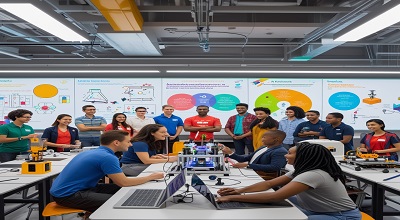Maker Education Training
Maker Education Training: Maker education is an innovative approach to learning that emphasizes hands-on, project-based experiences. It encourages students to explore, create, and innovate using various tools, technologies, and materials. Rooted in the maker movement, this educational philosophy fosters creativity, problem-solving, and collaboration.
What is Maker Education?
Maker education integrates STEM (Science, Technology, Engineering, and Mathematics) with arts and design, allowing learners to build, experiment, and iterate. It often involves:
- 3D printing
- Robotics
- Coding
- Woodworking
- Electronics
This approach shifts from traditional lecture-based teaching to active, student-centered learning.
The Importance of Maker Education in Modern Learning
Why is Maker Education Essential?
- Encourages Critical Thinking – Students solve real-world problems through experimentation.
- Promotes Creativity – Learners design and build unique projects.
- Develops Collaboration Skills – Team-based projects enhance communication.
- Bridges Theory and Practice – Students apply academic concepts in tangible ways.
- Prepares for Future Careers – Builds skills in tech, engineering, and design.
Impact on Student Engagement
Research shows that maker education increases motivation and retention by making learning interactive and fun.
Latest Trends in Maker Education Training
A. Integration of AI and Machine Learning
- AI-powered tools assist in prototyping and problem-solving.
- Chatbots and coding assistants enhance learning.
B. Virtual and Augmented Reality (VR/AR) in Making
- Students use VR to simulate engineering projects.
- AR overlays instructions on physical builds.
C. Sustainable Making
- Focus on eco-friendly materials and upcycling.
- Solar-powered and biodegradable projects.
D. Gamification of Maker Education
- Badges, leaderboards, and challenges motivate students.
- Platforms like Minecraft Education support maker-based learning.
E. Remote and Hybrid Maker Spaces
- Online maker communities and digital fabrication labs.
- Kits sent to students for at-home projects.
Key Components of Effective Maker Education Programs
A. Well-Equipped Maker Spaces
- Tools Needed: 3D printers, laser cutters, microcontrollers (Arduino, Raspberry Pi).
- Materials: Cardboard, sensors, craft supplies.
B. Skilled Educators
- Teachers trained in design thinking and project-based learning.
- Professional development workshops.
C. Student-Centered Curriculum
- Open-ended challenges instead of rigid instructions.
- Emphasis on failure as a learning tool.
D. Community and Industry Partnerships
- Collaboration with tech companies and local makers.
- Internships and mentorship programs.
How to Implement Maker Education in Schools?
1: Start Small
- Begin with simple projects like paper circuits or LEO robotics.
2: Secure Funding
- Grants, crowdfunding, and partnerships with tech firms.
3: Train Teachers
- Workshops on coding, electronics, and design.
4: Develop a Maker Curriculum
- Align projects with STEM standards.
5: Assess Progress
- Use portfolios and presentations instead of traditional tests.
Challenges and Solutions in Maker Education
| Challenge | Solution |
|---|---|
| High costs of equipment | Seek grants, use low-cost alternatives |
| Lack of teacher training | Online courses, peer mentoring |
| Limited classroom space | Mobile maker carts, shared spaces |
| Student fear of failure | Foster a growth mindset |
Future of Maker Education
- AI-driven personalized making experiences
- Global maker collaborations via IoT
- More focus on social impact projects
Conclusion
Maker education is transforming classrooms by fostering innovation, creativity, and problem-solving. With the latest trends like AI, VR, and gamification, it’s becoming more accessible and engaging. Schools must invest in training, tools, and partnerships to prepare students for a tech-driven future.
